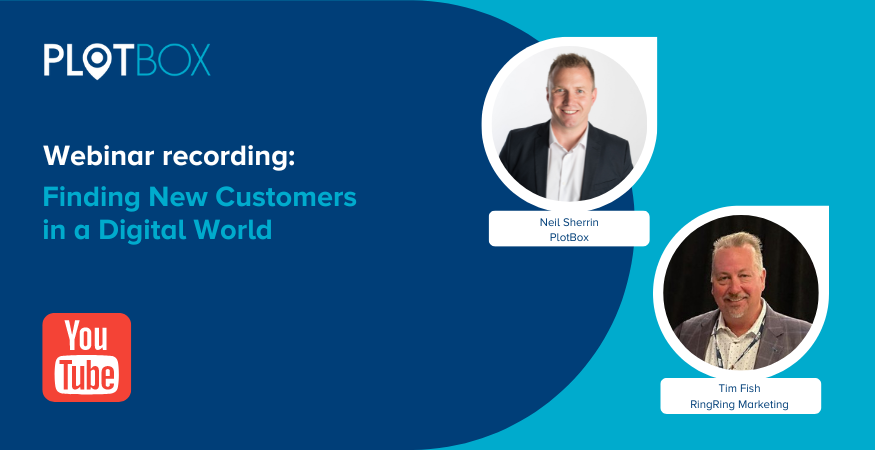| Read time: 7 mins
In a recent webinar, PlotBox VP Sales North America, Neil Sherrin was joined by Tim Fish, VP Sales and Business Development at RingRing Marketing who provided insights on how deathcare providers can find new customers - both at need and pre need - through digital marketing in our digital world.
RingRing Marketing is the premier digital agency for larger funeral homes and cemeteries. Specializing in social media marketing, pay-per-click advertising (PPC), search engine optimization (SEO), web design and review generation, their digital marketing strategies have helped hundreds of clients to increase their market share.
Here are some of the key takeaways:
Setting the scene
It's easy to think of marketing as awareness - it’s important, but for some it’s the ‘holy grail’ (“if only people knew what we have to offer, if only we could get them to see our pre-need ads in the paper, etc.”). That’s part of the story, part of the journey, but on its own it’s not enough - it’s not action.
With the myriad of options in terms of technology, tools, processes and ways of doing things, the challenge is how to distill them into priorities.
To find our way through that, we need to look at how the buyer has changed in recent times.
The changing buyer
The buyer is changing - or has already changed. Looking at two types - ‘Skeptical Steve,’ representing the ‘old world’, and the other, ‘Resourceful Rebecca’, representing the new.
Steve is skeptical of salespeople, he’s wary of their tactics, has limited technology, and crucially, the sellers he's interacting with have low adoption of technology for improving the buying journey.
In contrast, Rebecca is empowered by technology. She uses it for research because she's informed, she has more control over her buying process than Steve. She expects organizations to help her learn, to educate her and not to be pressured into a sale.
Rebecca is 50 - 70% through her buying journey before she even reaches out to sales - that means you are in a sales process right now, even if you aren’t aware of it. Rebecca is already shortlisting vendors - your job is to make that shortlist. When the power has shifted to the buyer, how do we exploit that?
That means engaging with people in new ways - being more active, being in places where people expect to be found and educating them.
The 'old world' vs the 'new world'
Finding the right mix between the old world and the new is important in the modern world. That mix will look different depending on a number of factors, including your business, your geography, and your communities. We need to be where Rebecca wants to buy, and we need to facilitate that process to make sure that she can find us when she's looking. Looking at two examples:
Two way vs one way communication
In the past, marketing was very much about broadcasting a single message - ‘one to many’, seeking to have a greater 'share of voice' than anybody else. While that’s still important, it’s not the only tool we have at our disposal now.
Technology has now enabled the customer to enter a dialogue on their terms - where and when they want us. It’s now less about simply telling people what we want them to know, it's about inviting and facilitating the conversation where and when prospects, the customer, and your communities want that.
Educational content vs sales pitch
The modern buyer starts their research without us and they start that online. They need to find the right information about us in the right channels. That doesn't mean they're ready to buy - our job at this stage is to make sure that we make the shortlist. Some examples of how we can do that are: by nurturing leads by email, answering questions through blog writing, and making use of reviews.
The bottom line here is that the people winning in business right now are those who understand that it's less about chasing the customer and more about helping them to find us when they’re ready.

Problem Aware Journey: At-need
From a digital perspective, in terms of deathcare, we might consider two primary customer journeys: at-need and pre-need.
The ‘at-need’ problem-aware journey is a family that either something has happened or is about to happen, and do not have a relationship with your cemetery at all.
The first place they will go to is a search engine - for 85% of the people that will mean going to Google and using search terms such as, “cemetery near me”, “cremation near me” etc. They're looking for information to help them solve a problem that is about to exist.
In terms of our old vs new journey, the goal is to drive them to your website, which is where they will be carrying out their evaluation of whether you can meet their needs. It’s important, therefore, to consider what you look like digitally while they’re shortlisting at that point - is there information there that could help them make a determination and find out more about you? What do your reviews look like online? Are you responding to all - good and bad? Those are critical for consumers in driving decision making.
From a problem aware standpoint, rather than a transaction at this point, the ultimate goal from this journey is to turn that into a phone call.
Intent based branding and pre need
Google is essentially the ‘yellow pages’ of today. Where people traditionally may have thumbed through a thick yellow book (many still do), then entered a protracted buying process, Google is now where they go to find where they need their information.
Intent based branding is how you build awareness of who you are with your community before they get to the problem aware stage. The goal here is to brand your business as the place they call when a problem arises.
“Stop the scroll”
For a deathcare demographic of primarily women over 60, that means social media marketing via Facebook - and a comprehensive Facebook strategy.
Interruption-based marketing is predicated on ‘stopping the scroll’ long enough to get a comment and a share.
When someone is scrolling through their feed, it's important that something about you resonates with them. We want to catch their attention briefly enough to have them leave a comment and then share that with their network - leveraging the power of their friends list to get your message out.
In terms of their journey, they already know who you are, and in their time of need will come to you. Even if they don't, the rest of that process can still go on - they know who you are and are still going to visit your website to check you out.
We want to make sure that we're branding our business so that at that time a need, they know who to call or what website to visit - and in that way, you can eliminate the competition.
Social Media Topic map
When communicating on social media or using social media marketing, it’s useful to first create an avatar of your customer. This will help you to tailor content that’s relevant to them.
Not every post should be about ‘the sell’ - if buyers are constantly faced with messaging that screams, “buy me”, they’re much more likely to scroll past quickly.
Think about a mix of topics or themes - we don’t necessarily want to remind people about death, especially given the demographic, but rather, provide added value that shows we care about them and builds engagement. Think about that when posting. Some topics relating to cemeteries or deathcare may include: finance, retirement, or healthy living.

The importance of reviews
According to a BrightLocal survey, 80% of American consumers say they trust online reviews as much as personal recommendations - think about how powerful that is.
The old saying that “if somebody did something excellent, you'd tell one person, but if somebody did something terrible, you'll tell 10 people”, still resonates. In the digital space, people give a positive or negative review as much weight as if it came from somebody that they actually know. That’s the importance of reviews.
In terms of the journey - 80% already know they will do business with you by the time they contact you…they're going to do business with you if they've got past that evaluation stage. As opposed to having to do all of the work from A-Z, much of that work is already done - and the gap you have to close is much smaller.
The best way to get reviews
The best way to get reviews? Ask for them. Understanding the potential sensitivities, it’s about timing, how you ask, and about communicating the value the review is going to have for other families.
At a very difficult moment in anyone’s life, this review will arguably help make it much easier for others to navigate the process. When people get that question at the right time, asked in the right way and the value explained, people may be much more receptive than you might think.
Importantly - make sure there is a place on your website for testimonials where they are easily accessible. Let the families you serve tell your story. That way, it's not a salesperson making the argument for you, it’s someone who has been through the process speaking from their own experience.
Learn more about RingRing Marketing.
For more insights, watch the webinar in full:

